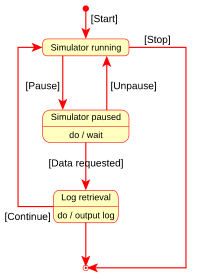State diagram (UML)

Example UML State diagram.
| UML diagrams |
|---|
| Structural UML diagrams |
| Behavioral UML diagrams |
The state diagram in the Unified Modeling Language is essentially a Harel statechart with standardized notation[1] ,[2] which can describe many systems, from computer programs to business processes. In UML 2 the name has been changed to State Machine Diagram. The following are the basic notational elements that can be used to make up a diagram:
- Filled circle, representing to the initial state
- Hollow circle containing a smaller filled circle, indicating the final state (if any)
- Rounded rectangle, denoting a state. Top of the rectangle contains a name of the state. Can contain a horizontal line in the middle, below which the activities that are done in that state are indicated
- Arrow, denoting transition. The name of the event (if any) causing this transition labels the arrow body. A guard expression may be added before a "/" and enclosed in square-brackets ( eventName[guardExpression] ), denoting that this expression must be true for the transition to take place. If an action is performed during this transition, it is added to the label following a "/" ( eventName[guardExpression]/action ).
- Thick horizontal line with either x>1 lines entering and 1 line leaving or 1 line entering and x>1 lines leaving. These denote join/fork, respectively.
References
- ↑ OMG (February 2009). "OMG Unified Modeling Language (OMG UML), Infrastructure Version 2.2".
- ↑ D. Drusinsky, Modelling and verification using UML statecharts, Elsevier, 2006
See also
External links
| Wikimedia Commons has media related to State diagrams. |
This article is issued from Wikipedia - version of the 5/12/2015. The text is available under the Creative Commons Attribution/Share Alike but additional terms may apply for the media files.

